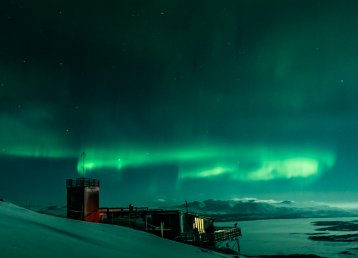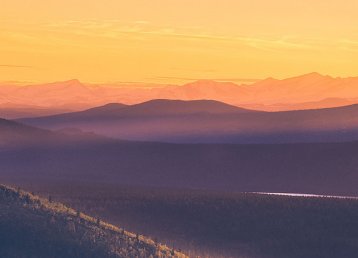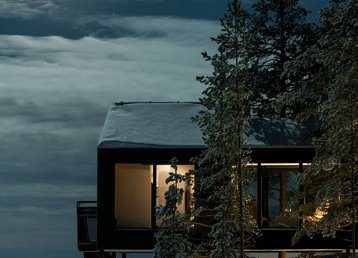This December morning is still a bit grey, and chilly as a scent of coffee starts to fill Conny Lundström’s kitchen in Kalvträsk. The winter sun seems to be in no hurry to make an appearance. Wildlife photographer Conny has a sip of coffee. Yesterday, on a private reconnaissance to his eagle hiding place, he found a white-tailed eagle and three golden eagles there.
— I got some nice shots, then I had to drive to Umeå for a meeting.
— Wow, that sounds great.
— But I’m not so convinced about today, to be honest. The weather is too nice. But tomorrow, when it’s snowing, I think it might be good.
— You think so?
— Yes, but it’s impossible to predict these things with certainty. After all, it’s wild animals and nature.
More than 25 years
But if you had to ask someone to make a prediction about the golden eagle, Conny Lundström would definitely be a safe bet. For more than 25 years, golden eagles and their habitat have shaped his life to a great extent.
A little while later, we are sat in his car, driving on forest roads beyond Kalvträsk – the place where he was born and a place that he has placed on the map in more ways than one. It has been snowing a lot, and the beginning of winter is lovely.
— I like this time of year when it comes to photographing from a hide. The days are not that long.
Life changing
In 1996 Conny took a picture that would change his life. He had always loved working with photographs and travel photography. His first published photo was taken at Trafalgar Square in London. He actually had no ambitions at all to become a wildlife photographer.
— But I started bringing my camera when I was hunting elks and other animals. After a couple of years, I realised I was sat aiming my camera more than I was my gun. I’ve sold all my weapons now.
— I guess it’s the kind of journey some of us do. For me, it became natural to take pictures of game instead of taking it down.
The picture that changed Conny’s world had a lot to do with the fact that he had seen a tree where he wanted to capture a golden eagle. One day, after he had been able to lure the eagle there with food, the light was absolutely perfect. He took the picture, and he liked it.
But even so, it was left lying around at home, for several years. Others also thought it was beautiful, and his friends said he should send it to a competition arranged by BBC Wildlife.
— I hadn’t even heard about that competition. But I sent it in in 1999, and a couple of months later a letter came from BBC Wildlife that said: “Congratulations Mr Lundström, you have won Wildlife Photographer of the Year”.
— It definitely means something, for sure. Besides, it was a really good start for my new company focusing on guiding and eagle hideouts to win the prize and then be featured in a big article in BBC Wildlife Magazine.
Wildlife photographer of the year
The picture was included in the book Wildlife Photographer of the Year, also produced by the BBC and the Natural History Museum, together with photos taken by other famous photographers who were presented with prizes that year. Conny’s photo was awarded best portrait, but there are several categories. When the BBC later did a ‘Best of’, featuring 20 years of the competition, his picture was chosen again, as well as photos by photographers such as Tim Laman, the Pickfords, Frans Lanting, Jim Brandenburg, Jan Töve and many other very famous people. That brilliant book is called Light on the Earth. It is an amazing journey for a picture that was left in his home office for three years.
"When you're sitting watching a golden eagle, it always surprises you how sneaky they are, how much wild is left in the eagle."
These days Conny’s hiding places in Kalvträsk are among the world’s safest bets if you want to have a close encounter with an eagle. But why eagles?
— I don’t really have a good answer to that. I was taking pictures of cities and travels. But then I realised it was something extraordinary. It’s such a special bird. Some individuals I’ve followed for nearly 20 years.
— The golden eagle is also top of the chain, which is a bit special. Other birds and animals respect it, and when two eagles meet, there is always a hierarchy, even if it’s a couple.
— When you’re sitting watching a golden eagle, it always surprises you how sneaky they are, how much wild is left in the eagle. It’s fascinating.
Squirrels
But an eagle hideout will present you with more than eagles. Smaller birds are always visiting, so are ravens and foxes. Ravens are excellent eagle spies – when a raven starts making warning sounds, you know it is time to get your camera ready. It also happens at times that a squirrel pays a visit. Perhaps that was what nature photographer Dani Connor fell for. She flew in to Kalvträsk to take pictures of eagles in the winter of 2019 but saw a squirrel on the last day and fell in love – if that is the right word to use. She asked if she could come back and help Conny take care of the hideouts in exchange for an opportunity to take photos and videos.
— It may be the case that I haven’t quite got the patience for taking pictures of eagles from a hiding place, she laughs.
— The squirrels were really rewarding to work with. It’s easier to get close, to build trust. Then when I found four orphan squirrels, it became something of a mission to take care of them.
Dani got very close to the four squirrel kits. She recorded their noises when they communicated. Kit Baby Pear had a very high-pitched sound that Dani captured and posted on her Twitter account. The directors behind a new sci-fi film saw the video and heard the sound. They needed a high-pitched scream but were unable to create it in their studio. That is the story of how a small squirrel known as Baby Pear became part of the sci-fi world, thanks to his high pitch. The BBC Wildlife has noticed Dani’s work on several occasions, and she has produced and published a film on squirrels through her own channels. They have gone rather viral.
Danni Connor Wild
Dani Connor came for the eagles but stayed for the squirrels. Watch her enticing documentary about how she connected to four little squirrels in Kalvträsk, Swedish Lapland.
Building trust
The reward is actually the same, whether it is an eagle or squirrel. That wait to capture an eagle, a squirrel, or a salmon is the same. When it happens, it is how long you have waited that determines the size of the reward. In Dani’s case, it was about staying in Kalvträsk longer than she had planned, and that she did not have the patience to sit inside a hiding place every day. She wanted to create her own style of photography.
— Yes, that’s how it is. When I came to Kalvträsk, it was to take a photo of a golden eagle. Conny has built a company as well as the eagles’ trust over the years, and I felt it was a bit the same with my squirrels. I wanted to learn more about them, and I wanted to interact with them.
— But then a tragic accident occurred, and suddenly I had four little kits that I needed to build trust with and simply save them. It took a very long time. I slept in a tent next to their tree for two weeks. That’s how long it took before I could even go outside, and they stayed without scaring them. It was special.
Eagle hides
Conny’s eagle hideout is located at the edge of a mire some kilometres from Kalvträsk. This is one of several hiding places. But it might be the most productive. He took his winning picture by this mire, and it is part of at least three eagle couples’ territories. They can easily come sailing in for a snack. We make a fire in the fireplace in the corner of the timbered cabin. It is not a luxury; it is purely functional. There are eight camera holes here and a simple outhouse.
— I guess we’ll make an espresso in a bit. Let’s see if something happens. Sometimes the eagles are sat there straight away in the morning. Sometimes you have to wait until after lunch. You can’t really predict anything other than the ravens letting you know if things are about to kick off.
"I probably have tens of thousands that I've never even looked at."
Conny has a lot of stories to tell about eagle encounters. He has so much experience photographing them that it’s difficult to take in.
— How many eagle pictures have you taken? Conny laughs:
— I probably have tens of thousands that I’ve never even looked at.
— So perhaps there is another BBC winner buried there on a hard drive?
— Not really. As a photographer, you pretty much know immediately if you’ve captured something really good. But I do have a lot of pictures that many would dream of having, for sure.
The golden eagle
The golden eagle, Aquila chrysaetos, is not Sweden’s biggest bird. The white-tailed eagle, for example, has a bigger wingspan. But even so, the golden eagle is the bird that sets the rules. When you get close to them, as you do in this hideout, you can see something almost prehistoric in the bird’s behaviour. It is so definite, so unfriendly – definitely a result of hierarchies and Darwin’s laws.
In Sweden today, you can find it in coniferous forests from the region Dalarna up to lake Torneträsk. More than half of all breeding pairs are found in the regions Västerbotten and Norrbotten. Conny says the eagles around his hideouts in Kalvträsk constitute a viable population. But a hundred years ago, in the 1920s, the eagle was nearly extinct in Sweden. After a tough discussion, it was put under protection. The golden eagle bounced back, but in the 1960s, it was harshly affected by environmental pollution. Toxins get more concentrated the higher up the chain you go, and eagles are at the top. Today’s big threats are modern society, the felling of trees where they nest, wind turbines and poaching, to some extent. It is estimated that there are more than 600 couples in Sweden, but the golden eagle is red-listed as near threatened in the Species database. A hundred years ago, however, there were hardly any. Conny has several territorial eagles around his hiding places. Suddenly there is a roar. The ravens that were quiet and hungry start to make a lot of noise.
— This is when it happens. Here it comes, says Conny and slides over to his pre-mounted camera.
As we take a peek out from the hiding place, there it is. With an expression that demonstrates awareness of who is the real star of the show. After a while, the camera shutter starts clicking. Perhaps some of the images will be good enough for a world-famous photographer. Or it might get stuck on a memory card and get lost. There is beauty in that.
Book a hide
Want to experience the Golden eagle and other animals in the arctic fauna? Visiting Conny and Wildshots Sweden, all year round, is then an excellent choice. Read more at connylundstrom.com
More wildlife photo in Swedish Lapland
Hide&See
Rajamaa
Scandinavian Sami Photoadventures












































